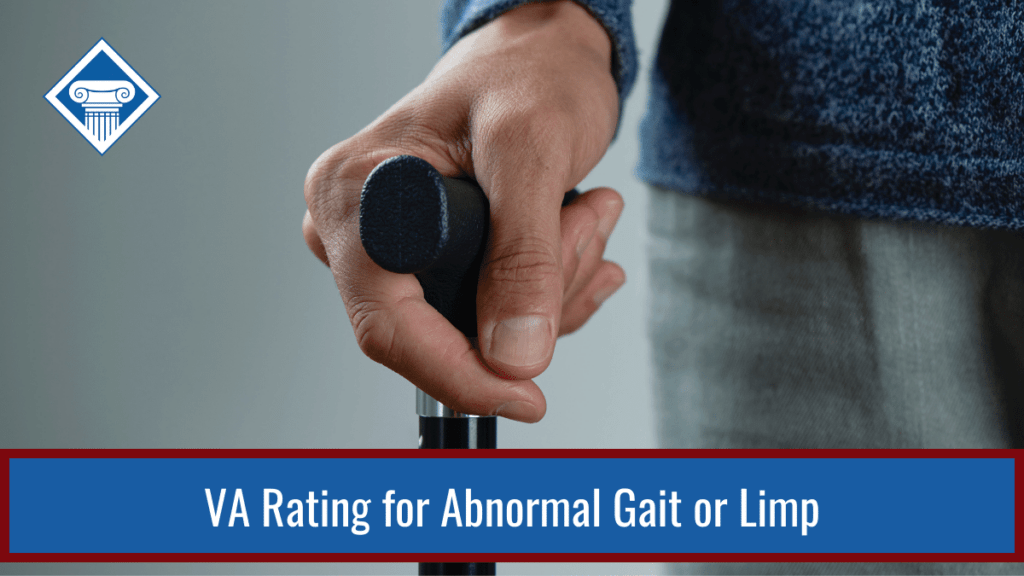Back injuries, joint problems, or chronic pain can all cause abnormal gait in veterans. Accidents or wear and tear while you were in the service can show up years later in a limp or frequent stumbling while you walk. Your limp may lead to additional injuries or orthopedic conditions over time. While you can’t receive a VA rating specifically for abnormal or antalgic gait, you may still be owed additional compensation if your limp is due to activities you engaged in during service and has caused other issues in your legs, feet, or back.
Talk to Us About Your Claim:
(812) 426-7200
In this article about VA ratings for abnormal gait:
What is antalgic or abnormal gait?
Gait refers to the way a person walks. The body systems that control walking don’t function as they should for someone with antalgic or abnormal gait. Any medical condition or injury to your brain, spinal cord, legs, feet, or back can cause abnormal gait. These conditions or injuries can cause you to limp, drag your toes, overcompensate with your other leg, shuffle your feet, or have general difficulty with walking and coordination.

Abnormal gait affects your mobility and quality of life. You may also experience pain when you walk and be more prone to falls.
In some instances, abnormal gait will clear up on its own, especially if it’s related to an injury, a medical professional treats it, and it properly heals. However, the condition can sometimes be permanent. It can also lead to secondary pain, injuries, or orthopedic conditions associated with the extra stress your altered walking pattern puts on your body.
Is there a VA rating for abnormal gait?
While you can’t receive a VA rating for your limp itself, it should be taken into consideration when evaluating the limitations of your service connected condition causing the limp. When you look to connect abnormal gait to your military service, consider what injury or other service-connected condition caused it.
If you had a normal gait before you entered the service and it’s now altered, think back to any illnesses or injuries during your time in service and any physical impact you experienced. There may be a service connection between your disability and limping.
Secondary conditions caused by abnormal gait
Abnormal gait often stems from injuries related to the feet, legs, hips, or back, among other conditions, and limping may result in additional conditions. Specifically, abnormal gait can cause secondary orthopedic problems, which means you may be able to service connect those issues.
Remember when your limp developed and what medical issues you’ve had since. Antalgic gait may cause you to favor one side of your body over the other. The pain or discomfort causing the limp will often leave you shifting your weight to the other side as quickly as possible when walking, which puts added strain and pressure on that side of the body. This strain can move from the foot all of the way up to the lower back, causing issues along the way.
For example, an old injury to your left ankle may cause you to limp and favor your right leg. Over time, this can begin to cause orthopedic issues in your right ankle, knee, or hip. It may cause severe lower back pain or pes planus of the foot. Your abnormal gait could affect multiple joints and muscles in the lower half of your body. If these issues stem from an injury or condition you incurred during service, you are owed additional compensation from the VA.
Conditions connected with abnormal gait can include:
- Back injuries
- Knee pain and injuries
- Hip issues
- Radiculopathy
- Degenerative disc disease
- Rheumatoid arthritis
- Osteomyelitis
- Fibromyalgia
- Myositis (muscle inflammation)
- Spinal cord injuries
- Pes planus and other conditions of the foot
In addition, some diseases, including Parkinson’s disease, multiple sclerosis, or stroke may result in abnormal gait development, which can also lead to the orthopedic issues listed.
Unemployability due to abnormal gait and orthopedic issues
Total disability based on individual unemployability (TDIU) benefits are for veterans who can’t keep or obtain gainful employment.
You may qualify for TDIU if you can’t work because of health conditions related to a limp resulting from your service. Your combined orthopedic conditions may make walking, bending, or sitting for long periods of time very uncomfortable or even impossible. They may cause you to struggle with lifting and carrying items at your job, or the pain may make focusing or sleeping at night more difficult. All of these factors can contribute to your inability to work.
“TDIU is such a big deal because you’re paid out the same as a 100% disability rating. If all of your conditions add up to 70% and you’re at 50% for mental health, but you just can’t seem to bump that rating any higher, proving that you’re unemployable due to your service-connected conditions can help you jump the gap and get to a 100% rating,” VA disability lawyer Zack Evans said.
“Regardless of your reason for leaving the workplace, if the medical evidence shows that your current service-connected conditions leave you unemployable, you could potentially win a TDIU claim,” Evans said.
“They brought me from being stuck at 30%. Denial after denial. Finally rated at 70%. Appealed for total and unable to work disability since 2014. Without Woods and Woods, I would still be stuck at 30%.”

F.H.
How our veterans disability lawyers can help
Woods and Woods has helped thousands of veterans get the VA benefits they deserve. Call us for a free case evaluation to find out how we can help. If we take your case, you only pay if you win, and we never touch your future monthly checks.
Talk to Us About Your Claim:
(812) 426-7200
FREQUENTLY ASKED QUESTIONS
If you can’t work as a result of orthopedic complications from a service-connected injury, you may qualify for TDIU benefits. These benefits provide a monthly payment if you can’t hold gainful employment.
There isn’t a specific rating for limping but it is often taken into consideration when weighing the severity of the condition causing the limp. In our knee example, you’d want to focus on the functional limitation from the injury to your knee as well as other conditions which may have been caused by the limp. For example, you may have ratings for secondary problems with your ankle, knee, hip, and back.

Neil Woods
VA disability lawyer
Woods and Woods
Neil Woods is the firm’s owner and president. He received his law degree from Western Michigan University.



